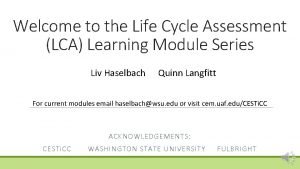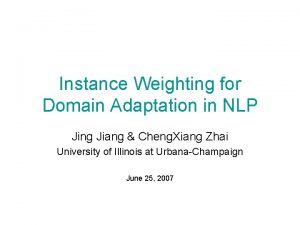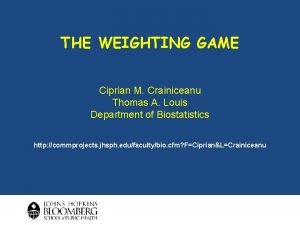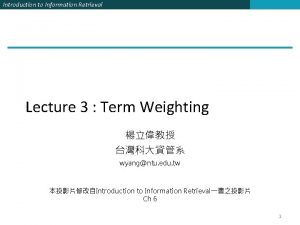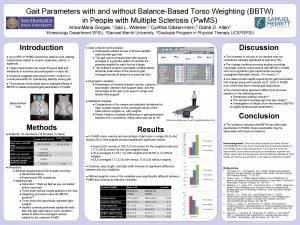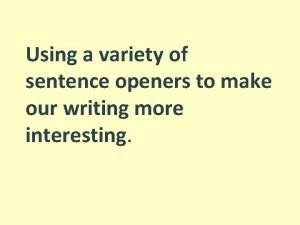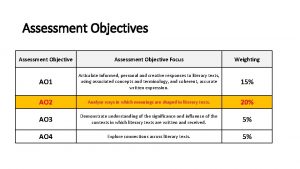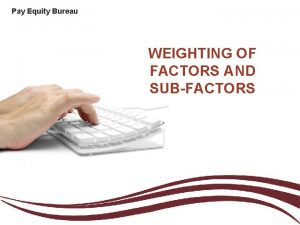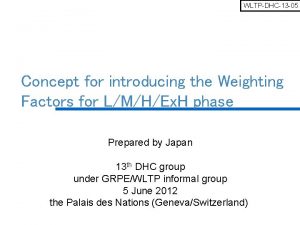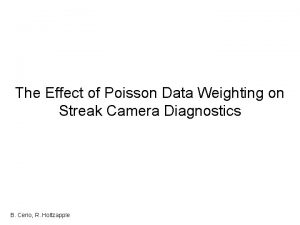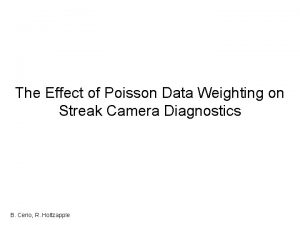Effect of varying weighting factors for various assessment















- Slides: 15

Effect of varying weighting factors for various assessment methods Boris Milašinović Faculty of Electrical Engineering and Computing, University of Zagreb, Croatia

Motivation � Inspired � by some previous work… Milašinović - Some experiences using various assessments methods with the emphasis on the automatic evaluation of (programming) assignments, Daad workshop in Durres 2008 � Predicting � students’ grades after 1/3 and 2/3 of the semester Matetić and Brkić - Analyzing Students' Behavior in a Beginner's Programming Course, Daad workshop in Bansko 2013 � Applying data mining techniques on students results � Unusual assessment points distribution (25 -4 -9 -2 -25 -6) � …and questions how sure we are in our points distribution? � what would happen if we change assessments weights? � 14 th Workshop on Software Engineering Education and Reverse Engineering 24 -30 August 2014, Sinaia, Romania

Case study data � Development � of Software Applications (DSA) The 3 rd year of bachelor study � Homework: 15 � Mid term exam: 20 � Classroom activity: 5 � Development � of Information Systems (DIS) The 1 st year of master study � Homework: 25 � Mid term exam: 20 � Classroom activity: 5 � Minimum � Quizzes: 20 Final exam: 25 Presence at lectures: 5 threshold 50% for each activity, except for classroom activity and presence at lectures � Data � Quizzes: 30 Final exam: 30 from the last three years Same weights and same semester organization 14 th Workshop on Software Engineering Education and Reverse Engineering 24 -30 August 2014, Sinaia, Romania

How we got those weighting factors? � Are 15 – 30 – 20 – 30 and 25 – 20 – 25 good ? � for homework, quizzes, mid-term and final exam, for DSA and DIS respectively � How we got them? � Estimating effort for a particular assessment � Mutually comparing values of assessments taking into account type of assessment (homework or classical test, type of tasks) � Rule of the thumb? 14 th Workshop on Software Engineering Education and Reverse Engineering 24 -30 August 2014, Sinaia, Romania

What would happen if we had changed those factors? � Many questions How many grades would change? � What would be average change in total points number? � What about points distribution? � �I started analysing current distributions and measure changes for all reasonable combinations where there is no component with more that 50% of points � excluding classroom activity and presence at lectures � � …and soon I wanted to change the title of the presentation to � How I tortured the data and the data refused to cooperate 14 th Workshop on Software Engineering Education and Reverse Engineering 24 -30 August 2014, Sinaia, Romania

Problems in points distributions � Almost none of assessments is normally distributed � It changes slightly (but not too much) if we observe only those above threshold and if we observe total points distribution � Weak correlations between various assessments � Significant number of students learn just to pass � Many quit after reaching threshold or desired grade � Furthermore, correlations change through years without pattern � Peaks near the threshold � Peaks where the higher grade starts => Nightmare for any prediction 14 th Workshop on Software Engineering Education and Reverse Engineering 24 -30 August 2014, Sinaia, Romania

Distributions – Total number of points (Only those students that have passed) � DSA 2012 2013 2014 � DIS 2012 2014 2013

Varying weighting factors of assessments � Discarded weights higher than 50 as not reasonable It would assume that one component is valuable than all others together � Also such weights yield higher number of changes � � Combinations with weights from 5 to 50 using 5 as a step 592 combinations for DSA � 540 combinations for DIS � � Measured for each combination (in comparison to the existing weights distribution) Average change in student’s total points � Number of grades changed � Maximum change of a single weight � Sum of changes of all weights � 14 th Workshop on Software Engineering Education and Reverse Engineering 24 -30 August 2014, Sinaia, Romania

Results for DSA: Average change in total points � X-axis: average change of points for a combination of weighting factors � There is no combination (of 592) that change (in average) total number of points more than 5 points (of 100) 2012 2013 2014

Results for DSA: Changes in grades � X-axis: number of students that would have different grade using a combination of weighting factors No of students per year: 58 - 75 - 57 � In many combinations significant number od students would have different grade but also many combinations produce only minor changes from original grades � 2012 2013 2014

Correlations for DSA 2012 Grade Avg Max. Dif • Grade Number of WDif changed grades Max. W • Avg 2013 Average change of total points Grade • Max. Dif Avg Highest change of Max. Dif total points • WDif Sum of absolute Max. W difference of 2013 weights • Max. W Grade Maximum single Avg change of weights Max. Dif WDif Avg Max. Dif WDif Max. W 0, 73 0, 68 0, 69 0, 93 0, 86 0, 88 0, 73 0, 93 0, 68 0, 86 0, 88 0, 69 0, 86 0, 78 0, 84 Grade Avg Max. Dif WDif Max. W 0, 91 0, 82 0, 79 0, 77 0, 91 0, 88 0, 86 0, 89 0, 92 0, 91 0, 84 0, 82 0, 91 0, 78 0, 89 0, 77 0, 86 0, 92 0, 84 Grade Avg Max. Dif WDif Max. W 0, 78 0, 7 0, 69 0, 95 0, 88 0, 83 0, 87 0, 79 0, 78 0, 7 0, 95 0, 69 0, 88 0, 87 14 th Workshop on Software Engineering Education and Reverse Max. W 0, 69 0, 83 0, 79 Engineering 0, 84 24 -30 August 2014, 0, 84 Sinaia, Romania

Results for DIS: Average change in total points � In 2013 & 2014 very similar to those from DSA � Little bit higher for year 2012 (up to 8 in average) but only for small number of combinations 2012 2013 2014

Results for ISD: Changes in grades � X-axis: number of students that would have different grade using a combination of weighting factors � No of students per year 33 – 27 - 32 � Relatively to number of students more changes in grades than for DSA but still many combination that change only few grades 2012 2013 2014

Correlations for DIS 2012 Grade Avg Max. Dif • Grade Number of WDif changed grades Max. W • Avg 2013 Average change of total points Grade • Max. Dif Avg Highest change of Max. Dif total points • WDif Sum of absolute Max. W difference of 2013 weights • Max. W Grade Maximum single Avg change of weights Max. Dif Avg Max. Dif WDif Max. W 0, 74 0, 67 0, 56 0, 47 0, 87 0, 48 0, 38 0, 5 0, 39 0, 74 0, 67 0, 87 0, 56 0, 48 0, 5 0, 47 0, 38 0, 39 0, 86 Grade Avg Max. Dif WDif Max. W 0, 73 0, 64 0, 69 0, 55 0, 92 0, 55 0, 42 0, 56 0, 49 0, 73 0, 86 0, 64 0, 92 0, 69 0, 55 0, 56 0, 55 0, 42 0, 49 0, 86 Grade Avg Max. Dif WDif Max. W 0, 74 0, 75 0, 44 0, 92 0, 54 0, 53 0, 55 0, 51 0, 74 0, 75 0, 92 WDif 0, 4 0, 55 Max. W 0, 44 0, 53 0, 51 0, 86

Conclusion � Doing comparison to present situation without knowing is the present situation good or bad � An idea was to immediately discard combinations that yields distributions that are not normal Cannot be done due „original” combination is not near normal distribution � Do we always have to aim toward normal distribution ? � Cannot be done as long as students tend to calculate and have different priorities? � � Small grade average changes in points yield not so small changes of Peeks - significant number of students learn just to pass, stop after achieving points for a grade or ask for additional point or 2 � In some other combination of weights they would act differently as it would directly affect the grades � � Minor changes in weights (e. g. ± 5, even ± 10 in some combinations) almost does not have effect � No need to worry if weights are not perfect ? 14 th Workshop on Software Engineering Education and Reverse Engineering 24 -30 August 2014, Sinaia, Romania
 Bees lca
Bees lca Instance weighting for domain adaptation in nlp
Instance weighting for domain adaptation in nlp Hkdse english
Hkdse english Ciprian m. crainiceanu
Ciprian m. crainiceanu Log frequency weighting
Log frequency weighting Anthony julius
Anthony julius Oer radiation
Oer radiation Websams cbt
Websams cbt Balance based torso weighting
Balance based torso weighting Exit sentence
Exit sentence Interesting sentence structures
Interesting sentence structures Equation of continuity for time varying fields
Equation of continuity for time varying fields Adverb sentence opener
Adverb sentence opener Equation of continuity for time varying fields
Equation of continuity for time varying fields Varying sentence openers worksheet
Varying sentence openers worksheet Cobol perform varying decrement
Cobol perform varying decrement
